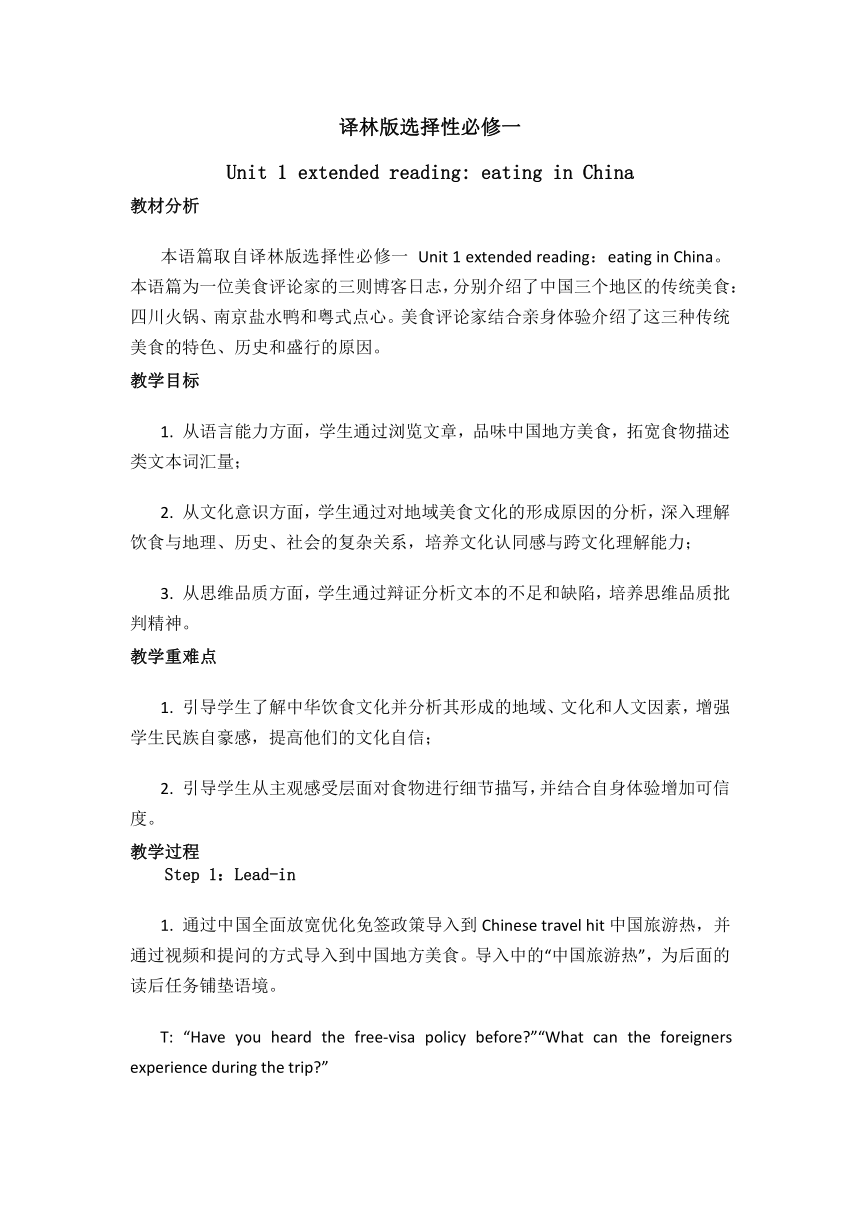译林版选择性必修一Unit 1 Food matters Extended reading Eating in China 教案
文档属性
| 名称 | 译林版选择性必修一Unit 1 Food matters Extended reading Eating in China 教案 |  | |
| 格式 | docx | ||
| 文件大小 | 13.6KB | ||
| 资源类型 | 教案 | ||
| 版本资源 | 牛津译林版(2019) | ||
| 科目 | 英语 | ||
| 更新时间 | 2025-07-13 17:59:13 | ||
图片预览

文档简介
译林版选择性必修一
Unit 1 extended reading: eating in China
教材分析
本语篇取自译林版选择性必修一 Unit 1 extended reading:eating in China。本语篇为一位美食评论家的三则博客日志,分别介绍了中国三个地区的传统美食:四川火锅、南京盐水鸭和粤式点心。美食评论家结合亲身体验介绍了这三种传统美食的特色、历史和盛行的原因。
教学目标
1. 从语言能力方面,学生通过浏览文章,品味中国地方美食,拓宽食物描述类文本词汇量;
2. 从文化意识方面,学生通过对地域美食文化的形成原因的分析,深入理解饮食与地理、历史、社会的复杂关系,培养文化认同感与跨文化理解能力;
3. 从思维品质方面,学生通过辩证分析文本的不足和缺陷,培养思维品质批判精神。
教学重难点
1. 引导学生了解中华饮食文化并分析其形成的地域、文化和人文因素,增强学生民族自豪感,提高他们的文化自信;
2. 引导学生从主观感受层面对食物进行细节描写,并结合自身体验增加可信度。
教学过程
Step 1:Lead-in
1. 通过中国全面放宽优化免签政策导入到Chinese travel hit中国旅游热,并通过视频和提问的方式导入到中国地方美食。导入中的“中国旅游热”,为后面的读后任务铺垫语境。
T: “Have you heard the free-visa policy before ”“What can the foreigners experience during the trip ”
S: “Chinese history, technology, landscapes, declicous food,etc.”
2. 通过提问和小红书美食博客的展示,让同学们了解food blog食物博客以及对blog可能包含的内容做出预测。
T: “If the foreign visitors have no idea what to eat, what can they turn to help ” “What aspects of the food may be included in a food blog ”
S: Food discovery apps, social media and blogs
S: Features, prices, history, reasons for popularity, personal experience, etc.
Step 2: Read for a gist
学生通过回答以下两个问题对该美食博客进行泛读,知悉作者途经四川、南京、广州等地分别品尝了火锅、南京盐水鸭、广式点心等地方美食。
Q1: Where did the food critic travel
Q2: What dishes did he try?
Step 3: Read for details
该文本为extended reading拓展阅读,文章包含三篇小短文,篇幅较长,因此该环节阅读模式为分组阅读,全班被分为三大组,分别完成每组的阅读任务。每组的阅读任务核心为梳理美食博客的美食信息,分析其受欢迎的原因以及反映的文化底蕴。
Task 1: read the first entry and match the details with the features.
Conclusion: Foods are not just foods. They reflect human’s ______. (possible answers: wisdom, adaptation, etc.)
Task 2: tick the box and underline related words/phrases.
Conclusion: Foods are not just foods. They mirror Chinese ______. (possible answers: traditional culture, etc.)
Task 3: tick the box and underline related words/phrases.
Conclusion: Foods are not just foods. They carry s______ meanings. (possible answers: social meanings, etc)
Step 4: Read for thinking
总结阅读任务所积累的食物表达方式,并通过提问的方式让学生们知悉食物博客的写作技巧。
Q1: What’s the function of the adjectives
Q2: What’s the function of the personal experience
Step 5: Post-reading task
该步骤回扣到导入部分的中国旅游热,要求学生利用所学的表达方式和技巧向来长沙旅游的外国游客介绍长沙地方美食-臭豆腐,写作形式是完成臭豆腐介绍的海报,其内容包括appearance, flavour, cooking way, texture and reasons for popularity or recommendation.
Step 6: Summary
总结三篇小短文的美食以及文化底蕴,并通过以下句式进行课堂主题的拔高
A bite of food is a bite of city.
A bite of food is a bite of culture.
A bite of food is a bite of people.
Homework
让学生们思考阅读文本是否是一篇完美的博客,是否还有其他细节可以补充,例如price,where to eat it。
Compulsory homework: polish your blog and add more details.
Optional homework: shoot a video based on your blog to make a recommendation.
Unit 1 extended reading: eating in China
教材分析
本语篇取自译林版选择性必修一 Unit 1 extended reading:eating in China。本语篇为一位美食评论家的三则博客日志,分别介绍了中国三个地区的传统美食:四川火锅、南京盐水鸭和粤式点心。美食评论家结合亲身体验介绍了这三种传统美食的特色、历史和盛行的原因。
教学目标
1. 从语言能力方面,学生通过浏览文章,品味中国地方美食,拓宽食物描述类文本词汇量;
2. 从文化意识方面,学生通过对地域美食文化的形成原因的分析,深入理解饮食与地理、历史、社会的复杂关系,培养文化认同感与跨文化理解能力;
3. 从思维品质方面,学生通过辩证分析文本的不足和缺陷,培养思维品质批判精神。
教学重难点
1. 引导学生了解中华饮食文化并分析其形成的地域、文化和人文因素,增强学生民族自豪感,提高他们的文化自信;
2. 引导学生从主观感受层面对食物进行细节描写,并结合自身体验增加可信度。
教学过程
Step 1:Lead-in
1. 通过中国全面放宽优化免签政策导入到Chinese travel hit中国旅游热,并通过视频和提问的方式导入到中国地方美食。导入中的“中国旅游热”,为后面的读后任务铺垫语境。
T: “Have you heard the free-visa policy before ”“What can the foreigners experience during the trip ”
S: “Chinese history, technology, landscapes, declicous food,etc.”
2. 通过提问和小红书美食博客的展示,让同学们了解food blog食物博客以及对blog可能包含的内容做出预测。
T: “If the foreign visitors have no idea what to eat, what can they turn to help ” “What aspects of the food may be included in a food blog ”
S: Food discovery apps, social media and blogs
S: Features, prices, history, reasons for popularity, personal experience, etc.
Step 2: Read for a gist
学生通过回答以下两个问题对该美食博客进行泛读,知悉作者途经四川、南京、广州等地分别品尝了火锅、南京盐水鸭、广式点心等地方美食。
Q1: Where did the food critic travel
Q2: What dishes did he try?
Step 3: Read for details
该文本为extended reading拓展阅读,文章包含三篇小短文,篇幅较长,因此该环节阅读模式为分组阅读,全班被分为三大组,分别完成每组的阅读任务。每组的阅读任务核心为梳理美食博客的美食信息,分析其受欢迎的原因以及反映的文化底蕴。
Task 1: read the first entry and match the details with the features.
Conclusion: Foods are not just foods. They reflect human’s ______. (possible answers: wisdom, adaptation, etc.)
Task 2: tick the box and underline related words/phrases.
Conclusion: Foods are not just foods. They mirror Chinese ______. (possible answers: traditional culture, etc.)
Task 3: tick the box and underline related words/phrases.
Conclusion: Foods are not just foods. They carry s______ meanings. (possible answers: social meanings, etc)
Step 4: Read for thinking
总结阅读任务所积累的食物表达方式,并通过提问的方式让学生们知悉食物博客的写作技巧。
Q1: What’s the function of the adjectives
Q2: What’s the function of the personal experience
Step 5: Post-reading task
该步骤回扣到导入部分的中国旅游热,要求学生利用所学的表达方式和技巧向来长沙旅游的外国游客介绍长沙地方美食-臭豆腐,写作形式是完成臭豆腐介绍的海报,其内容包括appearance, flavour, cooking way, texture and reasons for popularity or recommendation.
Step 6: Summary
总结三篇小短文的美食以及文化底蕴,并通过以下句式进行课堂主题的拔高
A bite of food is a bite of city.
A bite of food is a bite of culture.
A bite of food is a bite of people.
Homework
让学生们思考阅读文本是否是一篇完美的博客,是否还有其他细节可以补充,例如price,where to eat it。
Compulsory homework: polish your blog and add more details.
Optional homework: shoot a video based on your blog to make a recommendation.
同课章节目录
- Unit 1 Food matters
- Welcome to the unit
- Reading
- Grammar and usage
- Integrated skills
- Extended reading
- Project
- Unit 2 The Universal Language
- Welcome to the unit
- Reading
- Grammar and usage
- Integrated skills
- Extended reading
- Project
- Unit 3 The art of painting
- Welcome to the unit
- Reading
- Grammar and usage
- Integrated skills
- Extended reading
- Project
- Unit 4 Exploring poetry
- Welcome to the unit
- Reading
- Grammar and usage
- Integrated skills
- Extended reading
- Project
